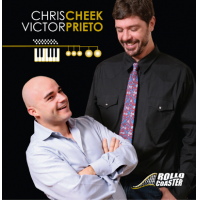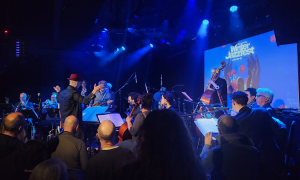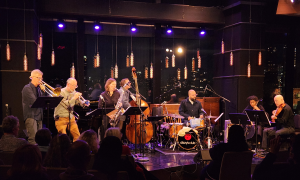Home » Jazz Articles » Live Review » Chris Potter's Underground at The Village Vanguard, NYC
Chris Potter's Underground at The Village Vanguard, NYC
Village Vanguard
New York City
January 10, 2010
Maybe there's something to be said for throwback music. It can feel comforting to hear new music laced with the crackle of an old LP, or the warm horn harmonies of a vintage gospel record. But as Gil Scott-Heron reminds us on his classic "B Movie," in politics indulging that nostalgia means "not to face now or tomorrow, but to face backwards"—stagnation in the name of security. The same goes for music.
Fortunately for us, Chris Potter's Underground spurns nostalgia. Its music is unrelentingly forward-looking—even when Potter turns his back on the audience to confab with his rhythm section, as the tenor saxophonist often did during the group's two sets at the Village Vanguard on January 10.
Underground is a sax-guitar-Rhodes-drums quartet that specializes in establishing grooves and then ripping them apart. The group's deconstructed vamps often smack of Miles Davis' Bitches Brew, only further ahead: they're as prescient now as that record was 40 years ago.
As on Underground's three albums, the grooves took center stage at the Vanguard; but unlike the recordings, each member of the rhythm section shone as prominently as Potter did. This musical egalitarianism is what made the performance so magnificent.
In fact, it was drummer Nate Smith who stole the show. All night, he refused to make sense. His commanding but glitchy performance hung perpetually on the edge of a cliff—by the skin of its own teeth- -and he was never more lost than found or more found than lost. As soon as Smith located a comfortable spot, he usually tossed it away, and this kept the concert feeling endlessly incipient; amidst all the band's vamping, its drummer would not stay put.
Smith eschewed beats or consistent patterns of any kind. He struck one drum at a time, often leaving considerable space in between. He was frequently seen with a contorted expression on his face, raising his arm high into the air and struggling to find the right time to strike—like a composer in the midst of a creative onslaught, holding the pen above staff paper while trying to decide exactly what note to scribble down.
Early in the first set, during a new Potter original called "Toot," Smith took what might have been a marvelous solo by Craig Taborn on Fender Rhodes and turned it into a duet. The two slipped in and out of perfect unison, and traded the role of leader even as Taborn hammered rumbling chords and zipped up the keyboard with the force of an electrical current. Potter and guitarist Adam Rogers wisely stayed out.
Rogers, who favored a slightly creamy distortion, added a fortifying layer to Underground's fulsome sound. He doubled with Potter on the weightiest melodies, and his solos lived in the pocket more than anyone else's. But his original composition, "Rumples," a high point of the second set, boasted a melody that was as jagged and angular as it was flurried—and his solo stayed well outside the bounds.
Then there was Potter's sax. Taborn and Rogers dropped out for Potter's solo on the tune "Good Hope," which started out sounding like a 4/4 re-visioning of Coltrane's "Afro Blue," before segueing into its dominant calypso feel. His improvisations were aggressive and unyielding, and his full-bodied playing appropriately groove-based. But even as he stuck to a particular mode of the major scale or a certain rhythm, he was constantly building tension.
At times he broke apart his approaches before they fully formed, and at others he careened upward only to land on a high note that was decidedly outside the scale on which he had ascended. While his authoritative playing never sounded like a rough climb, neither did he allow himself to coast.
As "Good Hope" came to a close, Potter quietly picked up the bass clarinet and played the group's second- to-last tune of the night: the simple, soulful Ellington ballad, "Single Petal of a Rose." Jones put down his sticks, and Potter drew out the song's echoing theme from his horn's reedy underbelly. For a few breathless minutes, the constantly mutating groove that had defined the concert stopped altogether. The sound was ethereal.
All night, the freethinking musical minds that make up Underground had locked into rhythms so tightly that the players could annihilate them from the inside, like masterful double agents. But the depth of their virtuosity sank in fully on the Ellington piece, when they set aside the groove to meditate on a tempoless and timeless melody. Their treatment of the classic was hardly nostalgic.
Tags
PREVIOUS / NEXT
Chris Potter Concerts
Support All About Jazz
 All About Jazz has been a pillar of jazz since 1995, championing it as an art form and, more importantly, supporting the musicians who make it. Our enduring commitment has made "AAJ" one of the most culturally important websites of its kind, read by hundreds of thousands of fans, musicians and industry figures every month.
All About Jazz has been a pillar of jazz since 1995, championing it as an art form and, more importantly, supporting the musicians who make it. Our enduring commitment has made "AAJ" one of the most culturally important websites of its kind, read by hundreds of thousands of fans, musicians and industry figures every month.

























